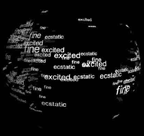February 09, 2006
Emotional Traffic

THE MECHANICS OF EMOTION
Playing instruments is the common lot of music. Playing with emotions is the common lot of politics and entertainment. Considering the Net as the World nervous system. Scanning the Web, we can get a real time image of the state of mind of the World. Starting from that data, we build up the dynamic maps of the emotions of the planet.
Emotional Traffic is a music/Internet on stage performance in which the emotions of the World are considered as music instruments. We (Jean-Baptiste Barričre and Maurice Benayoun) play the maps of the emotions extracted in real time from the Net. On stage a big screen that displays the mixing of the maps of different emotions. The maps are built in real time, with words, bigger or smaller according to the feed back from the Web. The words are coming one after another so that the increasing density of terms makes the sound more complex. Different lines scans the screen and the map of mixed emotions at a speed controlled by the directors in the big hall space.
5 smaller screens, like Kakemonos, display the projection of 5 seperate maps of emotions, presented like globes, from FEAR to SATISFACTION. A meridian line turns around each sphere, scanning the map, building the sound out of the map of the emotion considered as a musical score. The directors control the speed, the frequency, timbre and the texture of sounds.
A camera analyses the moves of the audience. One sound layer coming from the reading of the maps is a rhythmic component. This component becomes stronger when the audience move is higher and he rythmic component is lower when the audience is static. This feed back loop help the directors to create a reactive music that will capture the audience attention. In response the principle gives the audience, by playing with the feed back, a possible control of the system (move/rhythm loop).

World Emotional Mapping: It is now easy, thanks to any existing search engine running on the Web, to build a semantic map of any concept. Not even trying to understand what is behind a single use of one word, we know now how many times a word is used in correlation with another. For our purpose we track the words in correlation with locations. According to the number of occurrences, the original keyword is located on the map with the appropriate size.
The cartography of the emotions consists on automatically building the map of the emotions over the World. Though, the keyword "stress" is used in association with thousands of city, region and country names in order to get the resulting number of hits form an Internet search engine. This operation is done again and again so that we get a perfect representation of how a word describing an emotion is related, on the English speaking Web, to locations.
The WEM (World Emotional Mapping) is not neither a scientific representation nor an objective portrait of the World emotions but it shows how the digital mass medias monitor the World. One should notice that continents like Africa seem not to have any emotion. In fact, it is only not present on the Web at the right scale according to the actual population. [via information aesthetics]
Posted by jo at February 9, 2006 11:57 AM
